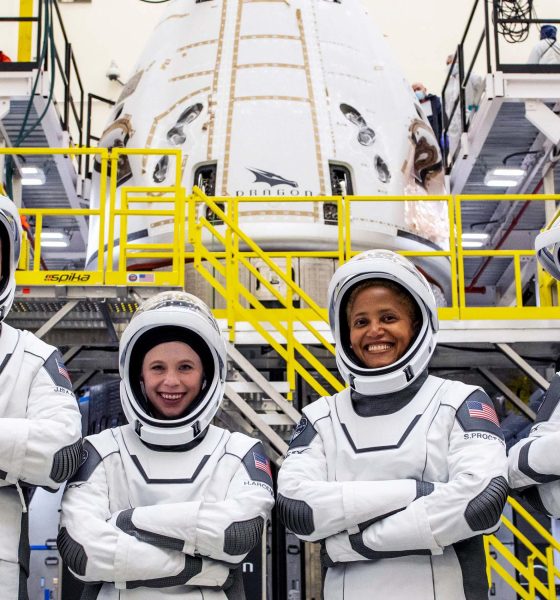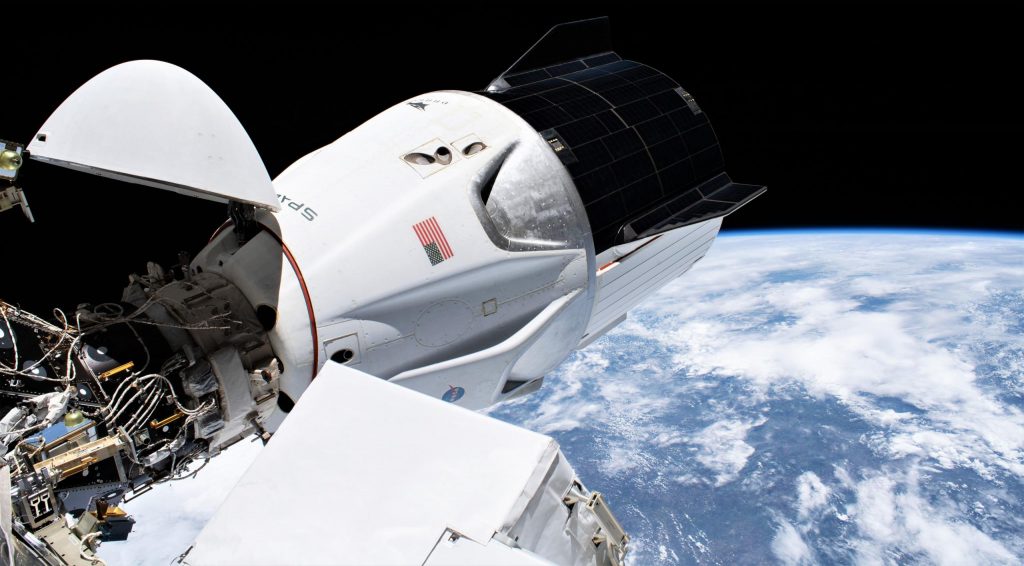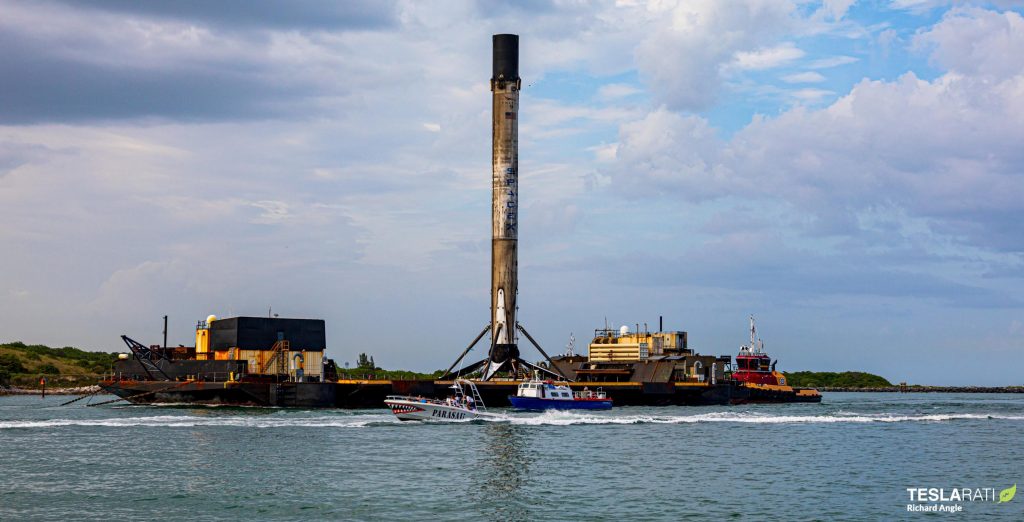

News
SpaceX Inspiration4 astronauts reveal Dragon’s ‘cupola’ in the flesh
SpaceX’s first fully private astronaut crew have revealed the first real look at a unique part of the Crew Dragon spacecraft that will carry them to orbit just two weeks from now.
Known as Inspiration4, the mission is the brainchild of Shift4 CEO, founder, and billionaire Jared Isaacman and will be the first orbital astronaut launch dedicated exclusively to space tourism. Unlike the side ventures of billionaires Jeff Bezos and Richard Branson, both of which cap out around 100 km (~62 mi) and Mach 3 (~1000 m/s) with vehicles that have minimal utility outside of their tourism roles, Inspiration4’s four-astronaut crew will be headed to orbit – 540 km (335 mi) at Mach 25 (>7500 m/s) – in a spacecraft designed and used to ferry NASA astronauts to and from the International Space Station.
A step further, aside from its more symbolic role in the potential future of orbital space tourism, Inspiration4 will also check off several major technical firsts – each impressive in its own right.
First and foremost, perhaps the most unique technical aspect of Inspiration4 will be the custom-built ‘cupola’ SpaceX has replaced Crew Dragon’s docking port with. Plans for the large transparent dome were revealed in March 2021 and according to Isaacman himself, SpaceX effectively took the idea from paper concept to real-world human-rated hardware in just six months. Initially shown off in an official render, Dragon’s ‘dome’ was portrayed as a completely uninterrupted glass-like hemisphere where the spacecraft’s docking port would normally go.
As a free-flyer mission with no need to rendezvous or dock with a space station, once-flown Dragon capsule C207 had no need for that module on Inspiration4 and SpaceX seemingly agreed. Six months later, the end result is practically identical to the renders aside from four black heat shields that will protect parts of the dome from the heat of Dragon’s four most important Draco thrusters. Regardless, the dome itself still appears to be uninterrupted, almost certainly making it the largest single-piece window ever flown to space when Inspiration4 launches later this month.
Additionally, Isaacman confirmed that SpaceX has also installed a custom camera inside the retractable nosecone the dome (and normally the docking port) is cocooned inside during ascent and reentry. In just the right position, that camera should be able to take some truly spectacular photos of Dragon’s four astronauts (Jared Isaacman, cancer survivor and PA Hayley Arceneaux, science communicator Sian Proctor, and raffle-winner Christopher Sembroski) silhouetted by Earth, space, and the stars.

Aside from SpaceX’s unique cupola modification, Inspiration4’s Crew Dragon capsule is on track to once again smash the company and world’s record for orbital space capsule turnaround. Previously tasked with supporting Crew-1, SpaceX’s first operational NASA astronaut launch, Dragon capsule C207 reentered and splashed down after six months in orbit on May 2nd and is now scheduled to launch four more astronauts as early as September 15th. If all goes according to plan, C207 will thus fly twice in ~136 days, beating a 227-day turnaround record set just weeks prior by 91 days (41%).

Meanwhile, SpaceX has also assigned Falcon 9 booster B1062 to launch Inspiration4, making the mission the first time a twice-flown Falcon booster launches astronauts. All told, it’s hard to imagine a better way to effectively ring in a new era of true space tourism. Stay tuned for updates as Inspiration4 tracks towards liftoff around Wednesday morning, September 15th.

Elon Musk
Elon Musk and Tesla AI Director share insights after empty driver seat Robotaxi rides
The executives’ unoccupied tests hint at the rapid progress of Tesla’s unsupervised Robotaxi efforts.

Tesla CEO Elon Musk and AI Director Ashok Elluswamy celebrated Christmas Eve by sharing personal experiences with Robotaxi vehicles that had no safety monitor or occupant in the driver’s seat. Musk described the system’s “perfect driving” around Austin, while Elluswamy posted video from the back seat, calling it “an amazing experience.”
The executives’ unoccupied tests hint at the rapid progress of Tesla’s unsupervised Robotaxi efforts.
Elon and Ashok’s firsthand Robotaxi insights
Prior to Musk and the Tesla AI Director’s posts, sightings of unmanned Teslas navigating public roads were widely shared on social media. One such vehicle was spotted in Austin, Texas, which Elon Musk acknowleged by stating that “Testing is underway with no occupants in the car.”
Based on his Christmas Eve post, Musk seemed to have tested an unmanned Tesla himself. “A Tesla with no safety monitor in the car and me sitting in the passenger seat took me all around Austin on Sunday with perfect driving,” Musk wrote in his post.
Elluswamy responded with a 2-minute video showing himself in the rear of an unmanned Tesla. The video featured the vehicle’s empty front seats, as well as its smooth handling through real-world traffic. He captioned his video with the words, “It’s an amazing experience!”
Towards Unsupervised operations
During an xAI Hackathon earlier this month, Elon Musk mentioned that Tesla owed be removing Safety Monitors from its Robotaxis in Austin in just three weeks. “Unsupervised is pretty much solved at this point. So there will be Tesla Robotaxis operating in Austin with no one in them. Not even anyone in the passenger seat in about three weeks,” he said. Musk echoed similar estimates at the 2025 Annual Shareholder Meeting and the Q3 2025 earnings call.
Considering the insights that were posted Musk and Elluswamy, it does appear that Tesla is working hard towards operating its Robotaxis with no safety monitors. This is quite impressive considering that the service was launched just earlier this year.
Elon Musk
Starlink passes 9 million active customers just weeks after hitting 8 million
The milestone highlights the accelerating growth of Starlink, which has now been adding over 20,000 new users per day.

SpaceX’s Starlink satellite internet service has continued its rapid global expansion, surpassing 9 million active customers just weeks after crossing the 8 million mark.
The milestone highlights the accelerating growth of Starlink, which has now been adding over 20,000 new users per day.
9 million customers
In a post on X, SpaceX stated that Starlink now serves over 9 million active users across 155 countries, territories, and markets. The company reached 8 million customers in early November, meaning it added roughly 1 million subscribers in under seven weeks, or about 21,275 new users on average per day.
“Starlink is connecting more than 9M active customers with high-speed internet across 155 countries, territories, and many other markets,” Starlink wrote in a post on its official X account. SpaceX President Gwynne Shotwell also celebrated the milestone on X. “A huge thank you to all of our customers and congrats to the Starlink team for such an incredible product,” she wrote.
That growth rate reflects both rising demand for broadband in underserved regions and Starlink’s expanding satellite constellation, which now includes more than 9,000 low-Earth-orbit satellites designed to deliver high-speed, low-latency internet worldwide.
Starlink’s momentum
Starlink’s momentum has been building up. SpaceX reported 4.6 million Starlink customers in December 2024, followed by 7 million by August 2025, and 8 million customers in November. Independent data also suggests Starlink usage is rising sharply, with Cloudflare reporting that global web traffic from Starlink users more than doubled in 2025, as noted in an Insider report.
Starlink’s momentum is increasingly tied to SpaceX’s broader financial outlook. Elon Musk has said the satellite network is “by far” the company’s largest revenue driver, and reports suggest SpaceX may be positioning itself for an initial public offering as soon as next year, with valuations estimated as high as $1.5 trillion. Musk has also suggested in the past that Starlink could have its own IPO in the future.
News
NVIDIA Director of Robotics: Tesla FSD v14 is the first AI to pass the “Physical Turing Test”
After testing FSD v14, Fan stated that his experience with FSD felt magical at first, but it soon started to feel like a routine.

NVIDIA Director of Robotics Jim Fan has praised Tesla’s Full Self-Driving (Supervised) v14 as the first AI to pass what he described as a “Physical Turing Test.”
After testing FSD v14, Fan stated that his experience with FSD felt magical at first, but it soon started to feel like a routine. And just like smartphones today, removing it now would “actively hurt.”
Jim Fan’s hands-on FSD v14 impressions
Fan, a leading researcher in embodied AI who is currently solving Physical AI at NVIDIA and spearheading the company’s Project GR00T initiative, noted that he actually was late to the Tesla game. He was, however, one of the first to try out FSD v14.
“I was very late to own a Tesla but among the earliest to try out FSD v14. It’s perhaps the first time I experience an AI that passes the Physical Turing Test: after a long day at work, you press a button, lay back, and couldn’t tell if a neural net or a human drove you home,” Fan wrote in a post on X.
Fan added: “Despite knowing exactly how robot learning works, I still find it magical watching the steering wheel turn by itself. First it feels surreal, next it becomes routine. Then, like the smartphone, taking it away actively hurts. This is how humanity gets rewired and glued to god-like technologies.”
The Physical Turing Test
The original Turing Test was conceived by Alan Turing in 1950, and it was aimed at determining if a machine could exhibit behavior that is equivalent to or indistinguishable from a human. By focusing on text-based conversations, the original Turing Test set a high bar for natural language processing and machine learning.
This test has been passed by today’s large language models. However, the capability to converse in a humanlike manner is a completely different challenge from performing real-world problem-solving or physical interactions. Thus, Fan introduced the Physical Turing Test, which challenges AI systems to demonstrate intelligence through physical actions.
Based on Fan’s comments, Tesla has demonstrated these intelligent physical actions with FSD v14. Elon Musk agreed with the NVIDIA executive, stating in a post on X that with FSD v14, “you can sense the sentience maturing.” Musk also praised Tesla AI, calling it the best “real-world AI” today.








